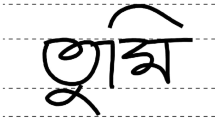Abstract
Segmentation of handwritten text into lines, words and characters is one of the important steps in the handwritten text recognition process. In this paper we propose a water reservoir concept-based scheme for segmentation of unconstrained Oriya handwritten text into individual characters. Here, at first, the text image is segmented into lines, and the lines are then segmented into individual words. For line segmentation, the document is divided into vertical stripes. Analysing the heights of the water reservoirs obtained from different components of the document, the width of a stripe is calculated. Stripe-wise horizontal histograms are then computed and the relationship of the peak-valley points of the histograms is used for line segmentation. Based on vertical projection profiles and structural features of Oriya characters, text lines are segmented into words. For character segmentation, at first, the isolated and connected (touching) characters in a word are detected. Using structural, topological and water reservoir concept-based features, characters of the word that touch are then segmented. From experiments we have observed that the proposed “touching character” segmentation module has 96.7% accuracy for two-character touching strings.
Similar content being viewed by others
References
Casey R G, Lecolinet E 1996 A survey of methods and strategies in character segmentation.IEEE Trans. Pattern Anal Mach. Intell. 18: 690–706
Chen Yi-Kai, Wang Jhing-Fa 2000 Segmentation of single- or multiple-touching handwritten numeral string using background and foreground analysis.IEEE Trans. Pattern Anal. Mach. Intell. 22: 1304–1317
Dimauro G, Impedevo S, Pirlo G, Salzo A 1997Automatic bankcheck processing: A new engineered system.Automatic bank check processing (eds) S Impedovo, P S P Wang, H Bunke (Singapore: World Scientific) pp 5–42
Fujisawa H, Nakano Y, Kurino K 1992 Segmentation methods for character recognition from segmentation to document structure analysis.Proc. IEEE 80: 1079–1092
Kim K K, Kim J H, Suen C Y 2000 Recognition of unconstrained handwritten numeral strings by composite segmentation method. InProc. 15th Int. Conf. on Pattern Recognition (Los Alamitos, CA: IEEE Comput. Soc.) pp 594–597
Liang J, Philips I, Haralick R M 1999 A statistically based highly accurate text-line segmentation method.Proc. 5th Int. Conf. on Document Analysis and Recognition (Los Alamitos, CA: IEEE Comput. Soc.) pp 551–554
Oliveira L S, Lethelier E, Bortolozzi F, Sabourin R 2000 A new approach to segment handwritten digits.Proc. of 7th Int. Workshop on Frontiers in Handwriting Recognition (Los Alamitos, CA: IEEE Comput. Soc.) pp 577–582
Pal U, BelaÏd A, Choisy Ch 2003 Touching numeral segmentation using water reservoir concept.Pattern Recog. Lett. 24: 261–272
Pal U, Datta S 2003 Segmentation of Bangla unconstrained handwritten text.Proc.7th Int. Conf. on Document Analysis and Recognition (Los Alamitos, CA: IEEE Comput. Soc.) pp 1128–1132
Zahour A, Taconet B, Mercy P, Ramdane S 2001 Arabic hand-written text-line extraction.Proc. 6th Int. Conf. on Document Analysis and Recognition (Los Alamitos, CA: IEEE Comput. Soc.) pp 281–285
Author information
Authors and Affiliations
Rights and permissions
About this article
Cite this article
Tripathy, N., Pal, U. Handwriting segmentation of unconstrained Oriya text. Sadhana 31, 755–769 (2006). https://doi.org/10.1007/BF02716894
Received:
Revised:
Issue Date:
DOI: https://doi.org/10.1007/BF02716894




